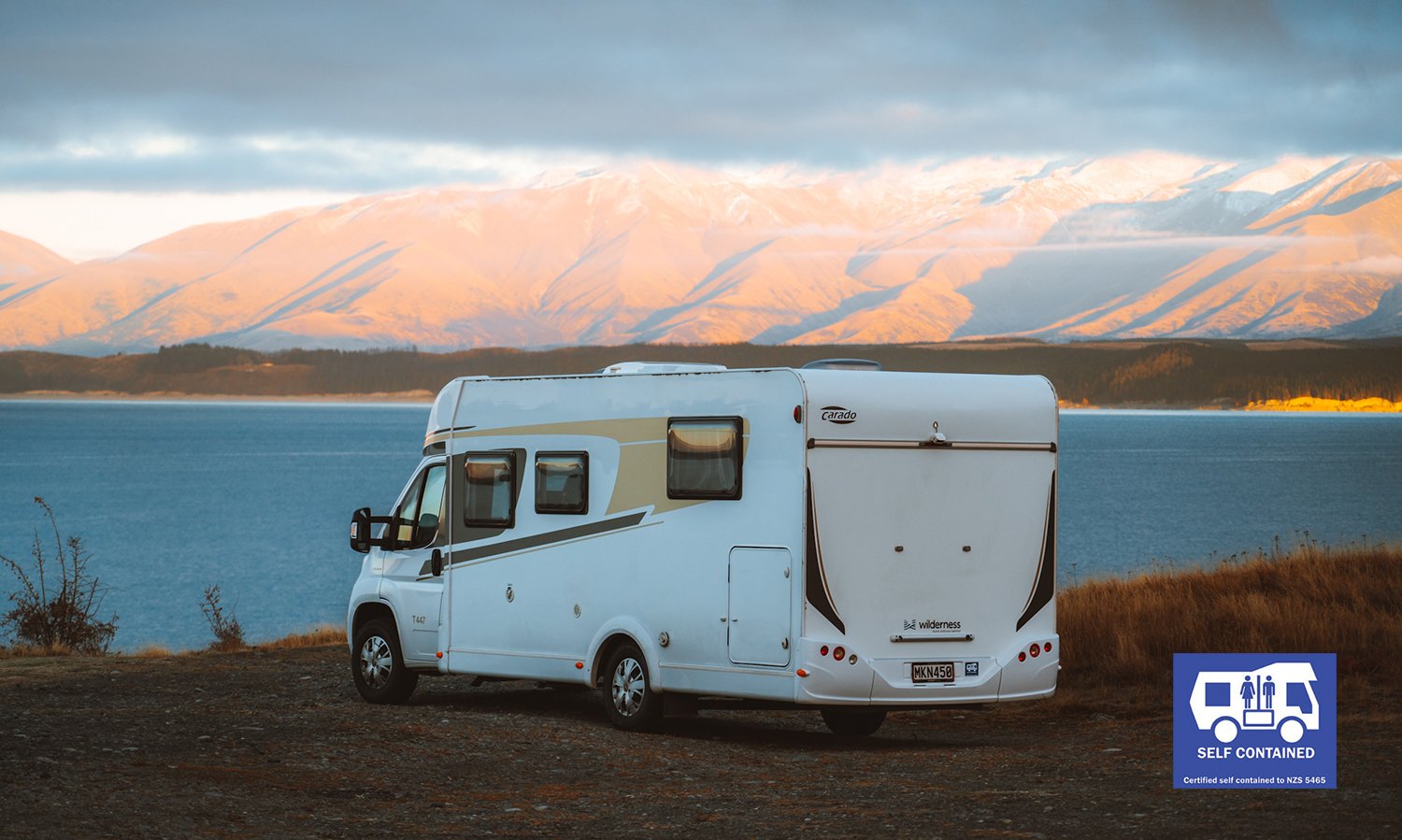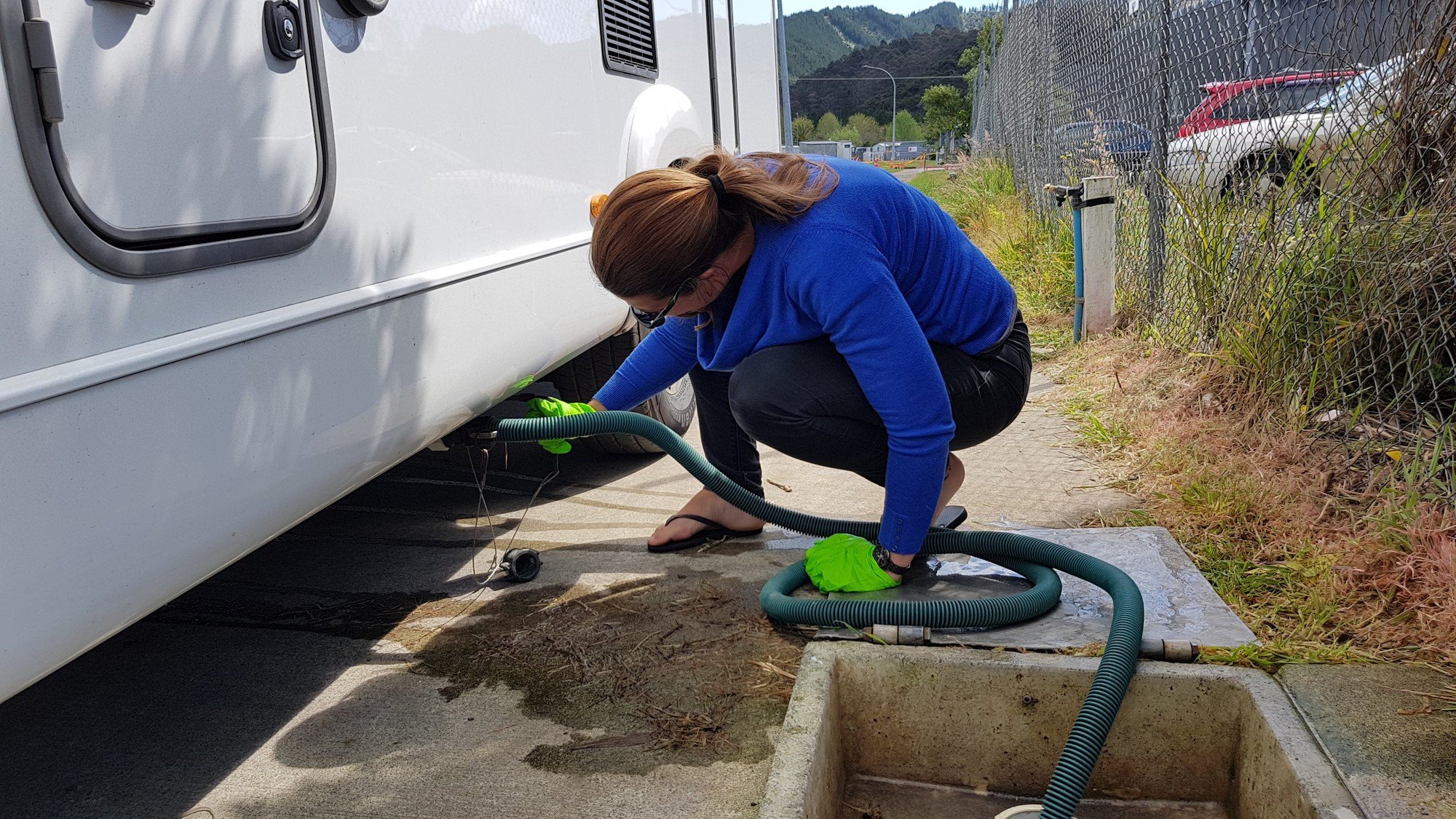A key differentiator between a high end motorhome and an ordinary one is the bathroom. It should be a welcoming space for you to refresh and revitalise.

Motorhome bathrooms should be both comfortable and practical. In high end, premium motorhomes, you can expect wood veneer cabinetry, sophisticated lighting and a self-contained shower — much like your bathroom at home. Although in some models, the bathroom may feel less like an oasis and more like the inside of a bathtub.
In this buyers’ guide, we discuss everything you need to know about RV bathrooms. We’ll touch on layout, features, water storage needs, freedom camping, and different types of toilets — along with how to use and empty them.
Types of motorhome bathrooms
There’s no escaping that a bathroom is a functional space. How the toilet, shower, and hand basin are placed inside your bathroom determines whether it’s considered a wet bathroom or a dry one.
Wet bathrooms

In a wet bathroom, the shower, toilet and sink are combined to maximise the use of space. It’s designed to be compact — but you’ll likely have to wipe down the toilet, walls and floor area after taking a shower.
Dry bathrooms
.jpg?width=1500&height=900&name=RS22212_TD745%20-%2015%20(1).jpg)
In a dry bathroom, a shower screen or wall separates the toilet from the shower. Not only will the toilet stay dry while showering, everything will — your basin, cabinetry and bathroom items. It may also feel like there’s more space compared to a wet bathroom.
Motorhome bathroom layouts
Recreational vehicle makers are becoming increasingly clever with bathroom layouts to help differentiate their product from competitors. The most common layouts you’ll come across are bathrooms where the toilet and shower are:
- Combined — the bathroom is usually oriented along one side of the motorhome but it can be across the back wall taking up the entire width. The shower may be separated from the toilet and vanity using a curtain or door.
- Separated — each has its own room often with one on the driver’s side and the other on the passenger’s side of the motorhome.
The benefits of different bathroom layouts
People new to motorhoming often assume that a separate shower and toilet is best. However, there are downsides to having two small rooms rather than one combo space.
So what are the benefits of each type of bathroom layout?
Separate shower and toilet
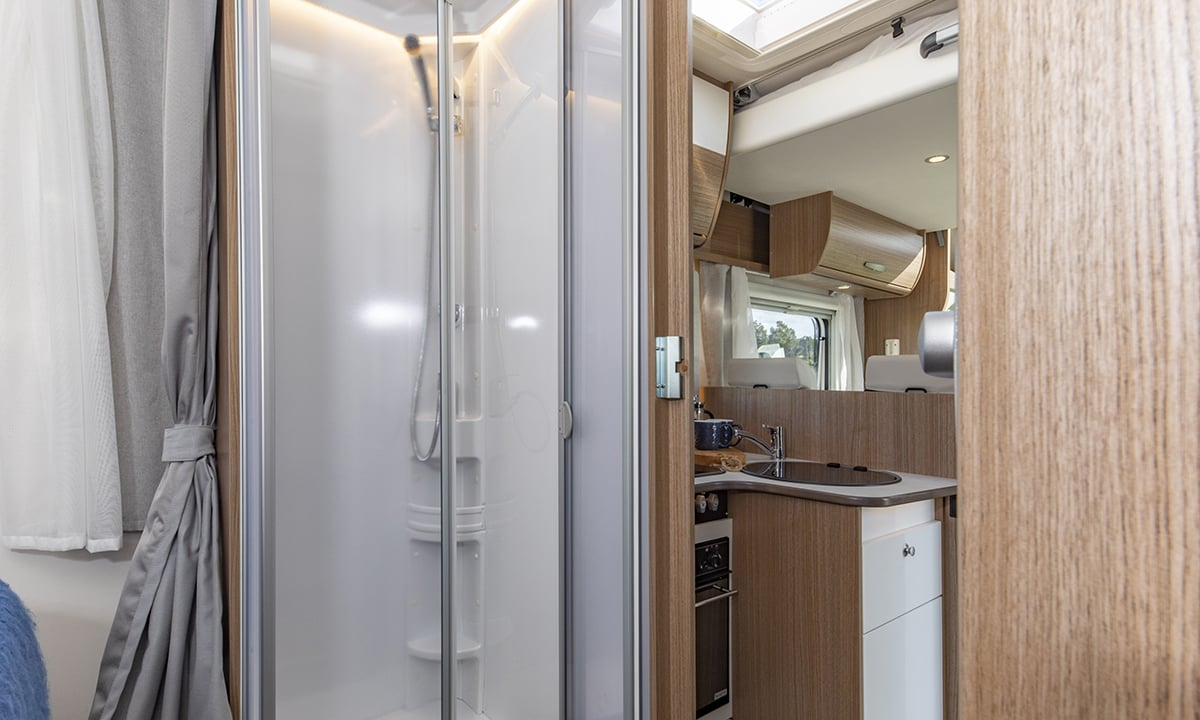
If you’ll be travelling with friends or kids often, this layout can be ideal. Having separate shower and toilet rooms allows both to be used at the same time. Just be aware that each room can be relatively small — so it may not work if you prefer (or need) space.
Ultimately though, you won’t need to wait for your partner or travel mate to finish showering before the toilet becomes free.
Combined shower and toilet
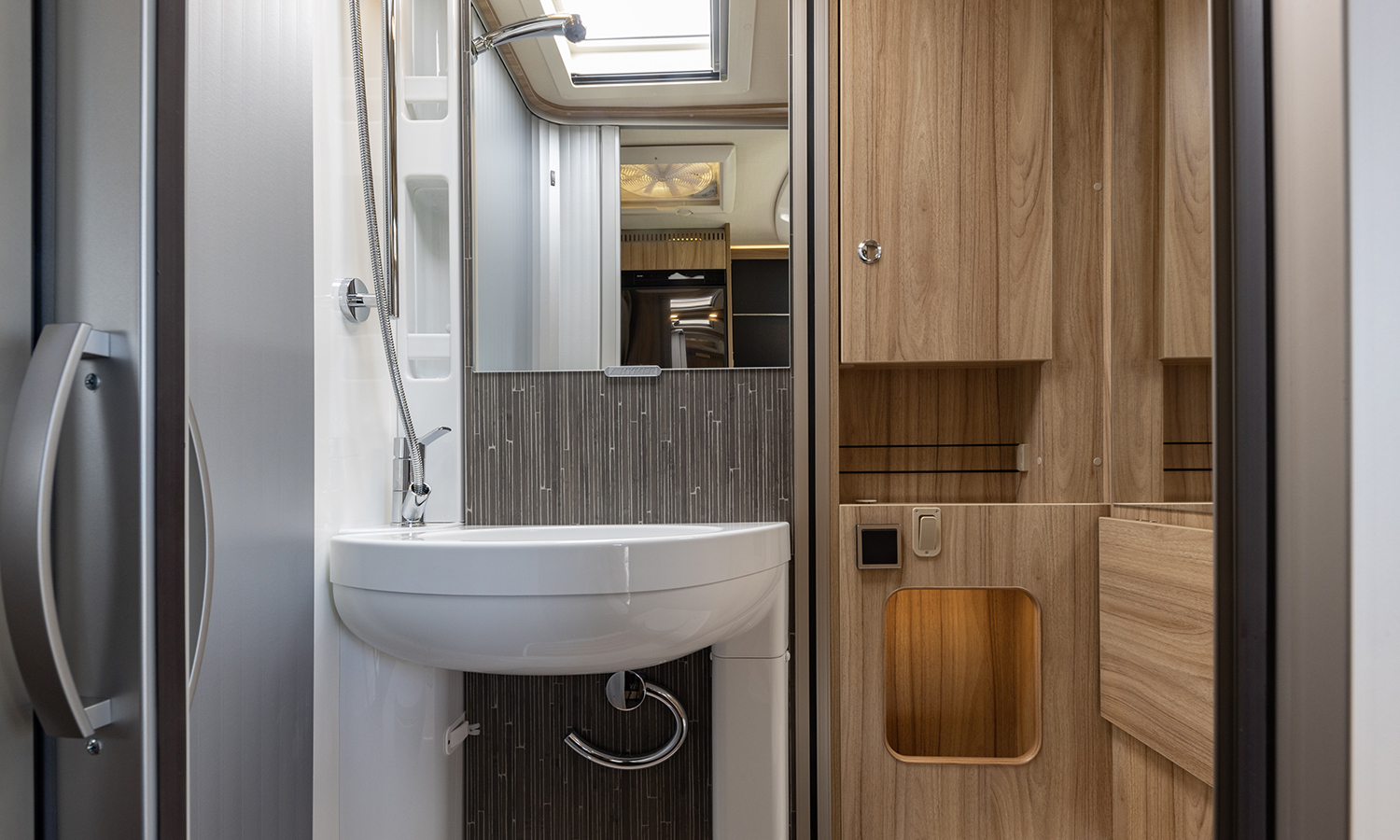
A combined shower and toilet can be perfect if you’ll mostly be travelling as a couple. The big advantage of having both in the same room is that combined, they’ll take up less space within your motorhome.
Your bathroom area will also feel bigger and be easier to move around in — compared to a toilet and shower in separate rooms.
Combined bathrooms in some standard motorhomes are designed so that the entire space gets wet when showering. Although that isn’t the case for high-end motorhomes with either an effective shower curtain or a shower door.
Check out our guide to motorhome length and layout.
Motorhome toilets
Early motorhomes built in the 1940s and 1950s had black water wastewater from toilets tanks which were made with poorly-designed drain valves. As a result:
- The tanks were a hassle to drain
- It was likely you’d get messy.
In 1963 it took an American, Frank Sargent, and his family to reengineer this troublesome black water drain valve into a breakthrough design. This was the beginning of Thetford Engineering and led to Sargent inventing the camping toilet — the basis of the well-known Porta Potti.
Thetford Engineering have become the undisputed leader in cassette toilets, providing a practical and convenient solution to an age-old problem. Today, practical motorhome bathrooms are not only viable but vital for a comfortable journey.
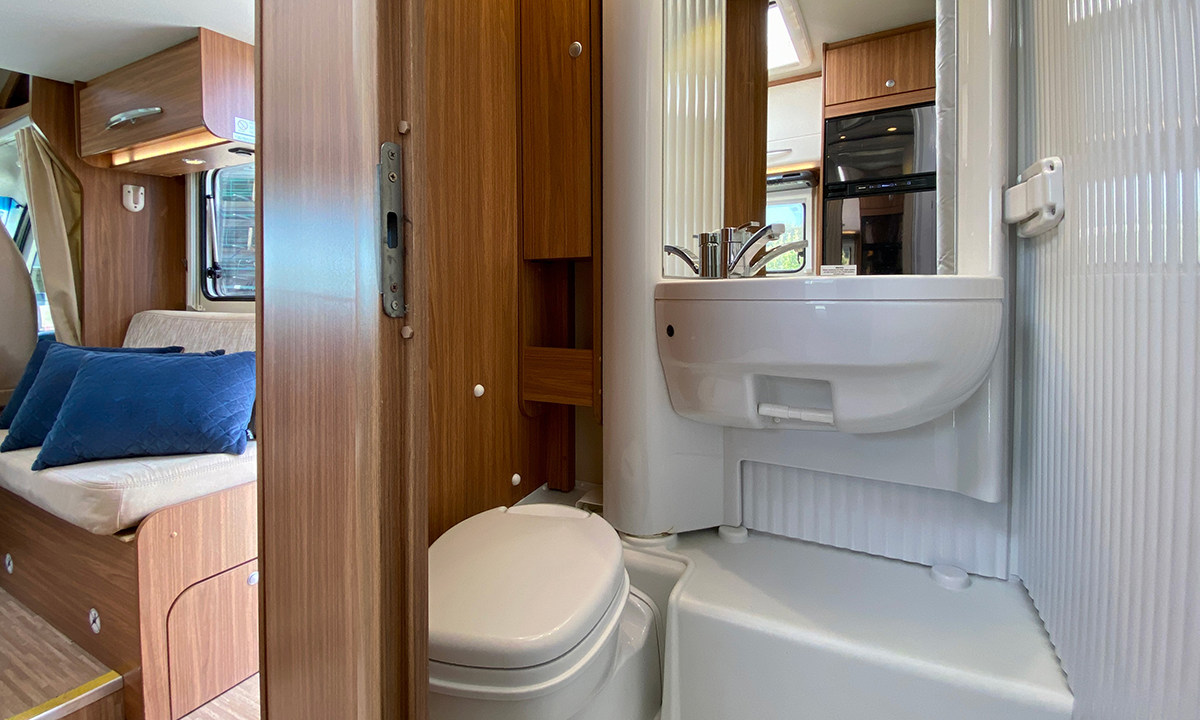
Types of motorhome toilets and their benefits
Motorhome toilets are either fixed to the floor or portable. If you’re considering a recreational vehicle that has a fixed toilet, the main difference will be the type of holding tank where the waste is collected.
The two most common types of motorhome toilets in New Zealand are cassette and portable toilets. Below we explain them in detail — while also covering less common kinds like gravity flush, macerating, and vacuum flush toilets.
Cassette toilets
The most popular kind of motorhome toilet in New Zealand is the cassette toilet. The toilet itself is a permanent fixture but the waste tank (cassette), which holds up to 18 litres of waste, is portable.
This allows you to remove it when it needs to be emptied.
Your cassette sits in a separate compartment below your toilet and is accessible through a locker door on the outside of your motorhome.
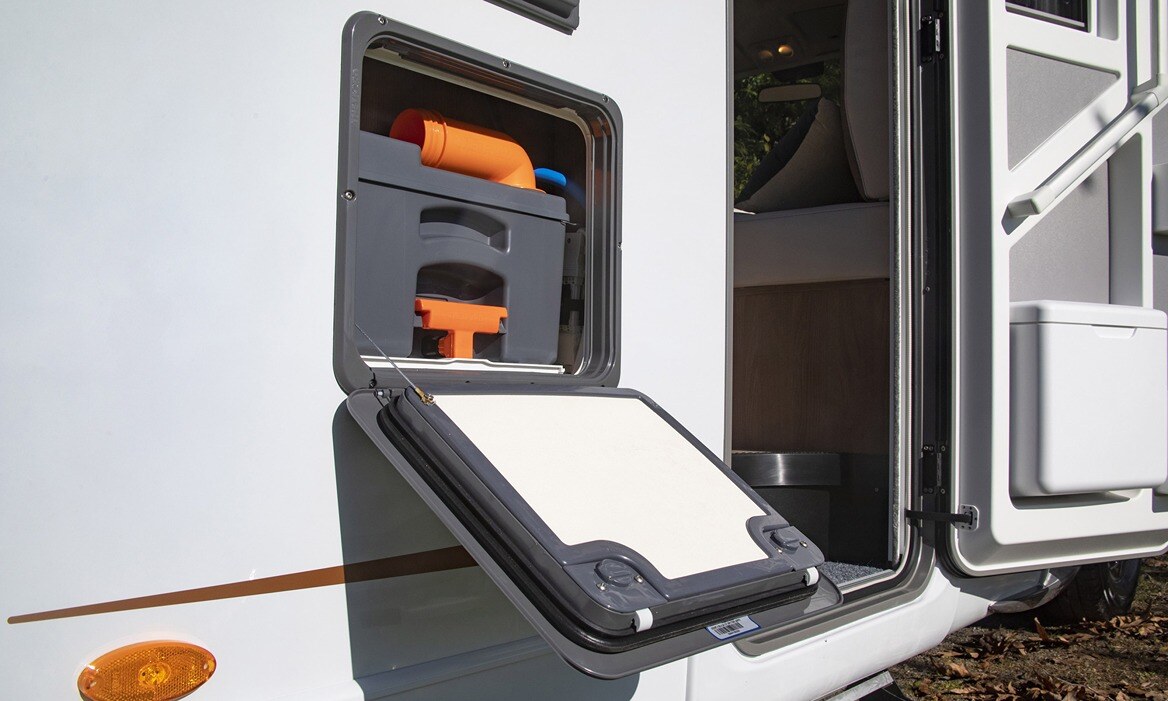
Your cassette toilet is plumbed into your motorhome’s fresh water system — supplying water to flush the contents. The toilet cassette needs to be emptied every few days, depending on use. It can only be emptied at a designated dump station.
The toilet itself can either have a fixed bench seat or a fixed stand-alone seat — similar to your toilet at home. It can also have a swivel seat which can be moved out of the way when not in use.
Cassette toilets are:
- Simple to use
- Quick to empty and put back in their locker
- Easier to get fixed or find parts compared to other toilets — as they’re the most common type.
If you plan to freedom camp away from civilisation for an extended period of time, consider purchasing a spare cassette.
Thetford and Dometic are the two major brands of cassette toilets.
Portable toilets
Portable toilets are commonly used in campervans and are usually stored under the bed. Designed as toilets with small holding tanks or cassettes attached to their bases, they’re emptied at dump stations like other RV toilets.
The benefits of choosing an RV with a portable toilet are that it’s:
- Portable — you can tuck it out of sight when not needed
- Small — a good option for smaller campervans or older recreational vehicles.
If you have a campervan with a portable toilet, there are more limitations on where you can legally park up for the night — compared to a cassette toilet. You’ll be able to stay at holiday parks and camping grounds but you won’t be able to freedom camp.
Camec, Thetford and Challenger are portable toilet brands you’ll find in New Zealand.
Gravity flush toilets
Gravity flush toilets have traditionally been used in RVs for decades and are still very common in recreational vehicles in the US — though not so much in New Zealand.
This type of toilet uses a simple flushing method where the contents drop directly into a black water holding tank with the help of pressurised water.
Unlike the tank in a cassette toilet, the holding tank in a gravity flush toilet is much larger but emptied in a similar way.
A sewer hose attaches to your RV connection point while the other end connects to the ground sewer connection point at a designated dump station. The benefits of choosing an RV with a gravity flush are that your toilet is:
- Similar to a standard household toilet
- Easy to flush — using an electric button or foot pedal.
The major disadvantage of the gravity flush toilet is that it’s designed for a full hook-up RV park — where there’s not only fresh water and electricity, but also a sewer service. These are uncommon outside the US.
At this type of camping ground, you’re able to connect directly to the sewer from your site. It’s likely to be one reason why gravity flush toilets aren’t so common in Australiasia or Europe.
Like cassette toilets, the two main manufacturers of gravity flush toilets are Thetford and Dometic.
Macerating toilets
Unlike a gravity flush toilet which discharges its contents directly into a black holding tank, a macerating toilet works by using blades powered by a motor to liquify (macerate) the waste — before it’s pumped into a holding tank.
Because this flushing technology pumps the waste, it allows the toilet to be positioned separately from its holding tank. Although macerating toilets offer greater flexibility with motorhome layout, they consume more water than standard gravity flush or cassette toilets.
Thetford, Dometic and Saniflo brands are popular choices of macerating toilet.
Vacuum flush toilets
Like macerating toilets, vacuum flush toilets can be located almost anywhere within a motorhome — as they use the same flushing technology.
Contents are pulled from your toilet bowl through a stored vacuum vessel and a macerating vacuum pump. They’re then pumped into a holding tank.
Dometic and Thetford also offer vacuum flush toilets.
Types of toilets you need to freedom camp in New Zealand

To be able to enjoy the country’s incredible freedom camping locations, your motorhome will need to be certified self-contained (CSC).
Certified self-contained motorhomes meet certain requirements around fresh and wastewater. They have enough capacity to service you and your passengers for at least three nights while making minimal impact on the environment.
The rules for ensuring a campervan or motorhome is certified self-contained mainly focus on the toilet and sanitation. The rules are continuing to tighten, meaning that portable toilets soon won’t meet the standards.
Get to know New Zealand’s self-containment standards.
Find out more about ensuring your motorhome is certified self-contained — so that you can legally freedom camp throughout the country.
How to empty your motorhome toilet
Regardless of the type of toilet in your motorhome or campervan, plan ahead where you’ll be able to empty it every two to three days. Avoid waiting for an indicator light to let you know that it’s time.
Dump its contents at your holiday park facility before leaving in the morning — or check dump station locations you’ll be passing during the day.
Emptying a toilet cassette
Cassette toilets generally need to be emptied after two to three days' use. However, you could extend this period by using public toilets when they’re available.
|
Finding a dump station Download a travel app like Campermate on Google Play or the App Store to find a designated dump station near you. |
A warning light will show on your toilet when the cassette is ready to be emptied. But also do a visual check of the contents in the cassette before you expect to see the warning light. When you need to empty the toilet:
- Drive to your nearest dump station
- Check that the flap in the toilet bowl is closed
- Open the toilet cassette locker on the outside of your motorhome
- Put on your protective gloves — biodegradable ones are commonly used
- Lift the release lever and pull out the cassette from its locker
- Swivel the spout outwards and remove its end cap
- Press the breather button while pouring the waste into the dump station drain
- Clean your cassette by filling it with water and gently agitating it
- Drain the contents of your cassette
- Repeat steps eight and nine until the water looks clear
- Add a little water and a toilet chemical like BioMagic Waste Tank Treatment for minimising bad smells.
Check out this short video showing how to empty a cassette toilet.
|
Motorhome Toilet Myths
|
Emptying a holding tank
If your motorhome has a gravity flush, macerating or vacuum flush toilet, it’ll also have a holding tank where the waste is stored.
Emptying a waste holding tank isn’t the most fun you can have on planet Earth. In some cases, it can be the reason why people choose a motorhome with a cassette tank instead.
To empty your holding tank, follow these steps:
- Drive to your nearest dump station
- Put on your protective gloves
- Take out your sewer hose and attach one end to the dump station
- Check that your black water tank valve is closed
- Unscrew the cap on your black water tank
- Attach the hose adapter and double check that it’s secure
- Open your black water tank valve — and you’ll hear the waste moving through the pipe
- After it’s empty, connect a garden hose to the rinse valve (if you have one) to flush through any
remaining waste - Let water run through it for a few minutes
- If you don’t have a rinse system on your motorhome, flush your toilet a couple of times
- Close the valve, disconnect the hose and rinse it through
- Add some fresh water and toilet chemical to your holding tank.
Once you’ve gone through this process, your RV toilet is ready to use again.
Emptying a portable toilet
Portable toilets usually have cassettes to store the waste — much like cassette toilets. To empty them:
- Drive to your nearest dump station
- Put on your protective gloves
- Remove your cassette in line with the manufacturer’s instructions
- Take off the pouring cap and release the air vent
- Empty the contents into the disposal point
- Top up your tank with water
- Close all points and shake to dislodge any remains
- Repeat steps six and seven until the water looks clear
- Secure the pouring cap and close the air vent
- Add a small amount of water and your preferred chemical to the tank
- Return your cassette to its place in your portable toilet.
What features to look for in a motorhome bathroom
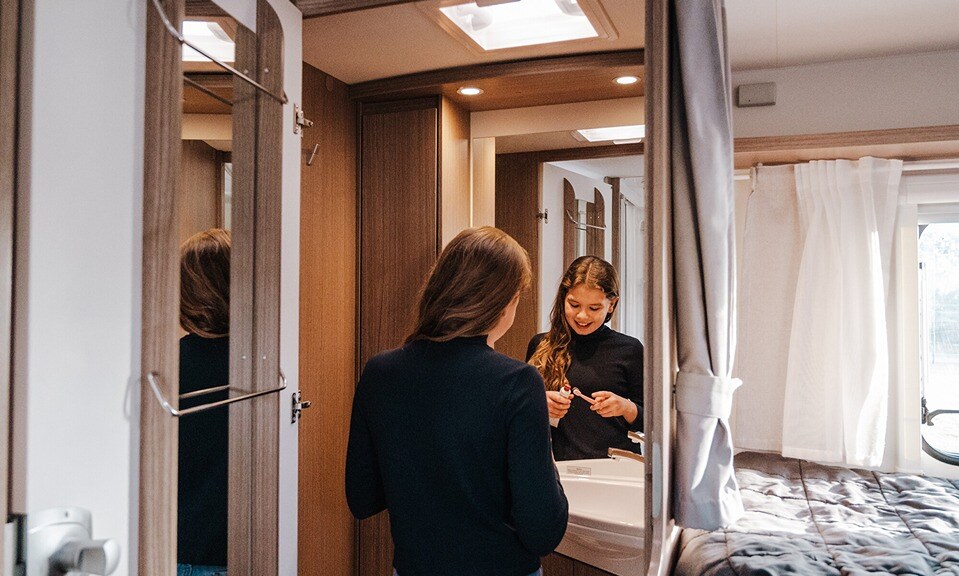
When weighing up different bathroom layouts and their features, look for a bathroom that’s super convenient yet doesn’t cut corners on comfort.
Ventilation
Humidity without adequate ventilation can cause mould. More effective venting through bathroom windows or ceiling vents will lessen the chance of mould build up. Look for a bathroom space that will let water vapour escape directly outside — rather than travelling via your living room.
Water saving shower head
Modern motorhomes are fitted with low pressure showers to help minimise water use and ensure you can freedom camp for multiple days without running out.
Test how easily adjustable the shower head is and its height placement — especially if you’re taller than most.
Dry storage space
If you purchase a motorhome with a combined shower and toilet, you’ll want plenty of dry space to store all your toiletry items. Removing toiletries and toilet paper from your bathroom before showering is a hassle.
Also look for shower caddies or corner baskets fixed in the shower. You’ll avoid tripping over bottles of shampoo or overreaching for the bar of soap.
Useful lighting
Test the lighting in each bathroom you view. Ideally you’ll have some natural light coming through the shower vents, with a few light switch options to suit different bathroom tasks.
See our guide to light, heating and ventilation for more on this topic.
Towel rails
The bathroom is not only the space to use the toilet or shower but also to dry towels and wet clothing. Check if there are easily accessible towel rails in place. At least one towel rail for each berth (person) is ideal.
Also determine whether the rails are well positioned for maximum airflow — so your towels or wet clothing can dry quickly.
Mirrors
Bathroom mirrors are just as essential in your motorhome as they are at home. Check they’re at the right height for daily tasks like brushing teeth and shaving.
Swinging wall
If you’re a bigger person who’s looking for a roomier, more spacious bathroom, the swinging wall design is a great choice. It’s a fantastic innovation you can find in some modern European motorhomes — where the swinging wall is used to separate wet and dry areas.
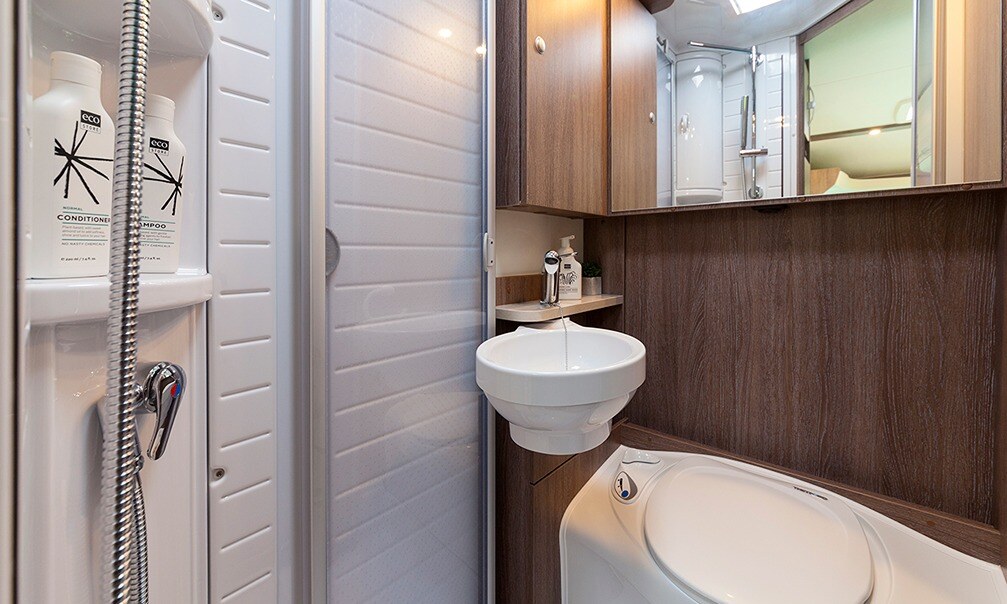
Rotating toilet bowl
A toilet bowl that can rotate up to 180 degrees will allow more space in your motorhome bathroom.
Drying room
If your prospective motorhome has central heating ducted into the bathroom and good ventilation, it can act as a drying room. Particularly useful in wet or cooler weather, a drying room helps by:
- Lessening the chance of mould in your living area
- Drying towels
- Being a place to hang wet clothing.
Check if you can close the living room vents and direct all of the motorhome’s central heating into the bathroom to create a more efficient drying room. Hang wet clothes and towels at night, close the door, and wake up to dry gear.
Download our guide on Features to Consider when Buying a Motorhome or List of The Most Overlooked Motorhome Features to learn more.
Motorhome water storage
Are you planning to spend consecutive nights freedom camping in a motorhome or campervan? If so, water is a precious resource. Assess how much you’ll likely use per day for showering, toileting, cooking and cleaning.
Fresh water
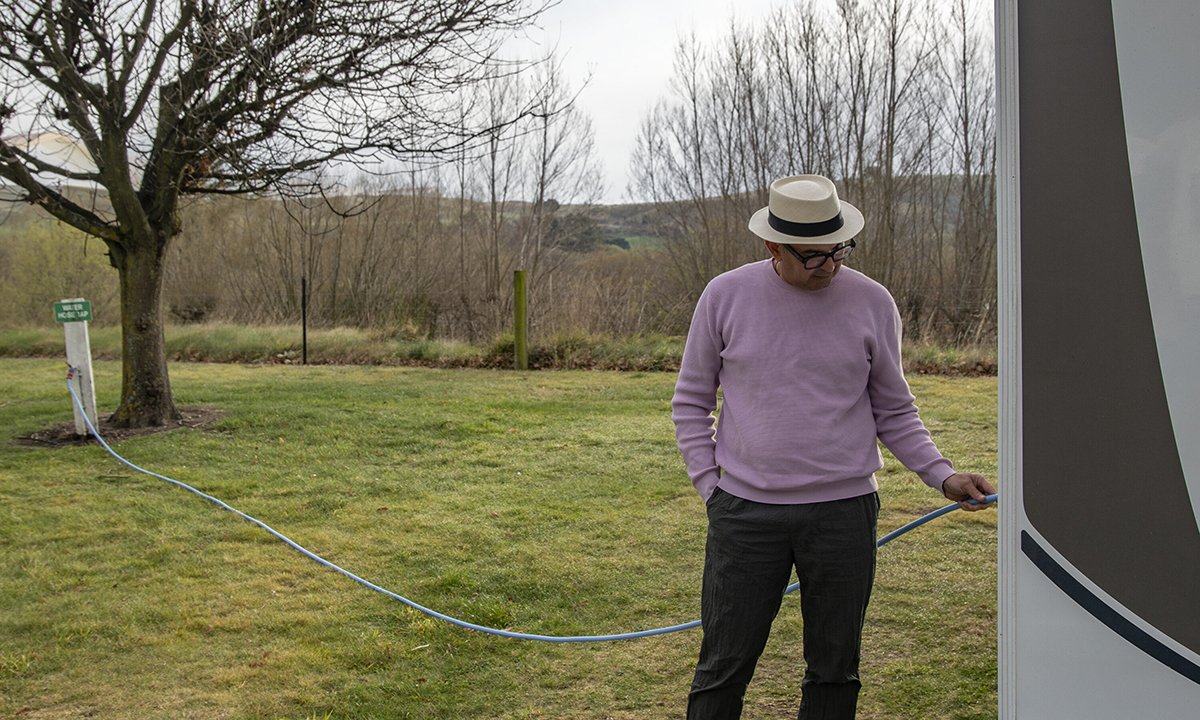
Refilling your fresh water tank is easy to do at public dump stations. How much you can carry will depend on the size of your tank. To meet the country’s self containment requirements, you’ll need at least 12L per person — the equivalent of three days off-the-grid.
Maximising your motorhome's fresh water
If you plan to stay off-grid for periods of time, ensure you have enough fresh water to last. Showering uses the most water so a few ways you can maximise usage is to:
- Buy an RV with water saving taps and shower heads
- Take short showers — and only one each day
- Lather up with the tap turned off before rinsing — also known as taking a navy shower.
And while you’re washing dishes, plug the kitchen sink to prevent wasting water.
Prudent use of your water supply can make the difference between a short stay in the wilderness and a longer one. You won’t need to upsize to a motorhome with bigger water tanks — or buy additional portable tanks which take up storage space and add extra weight.
See our article on weight and payload to avoid overloading your motorhome.
|
How much water is enough? Most modern European motorhomes carry around 120L of fresh water and hold about 90L of grey water. Campervans hold a lot less — while larger motorhomes built on heavier chassis may be able to store more than 400L. |
Grey water
Grey water is wastewater that typically comes from your motorhome shower, basin and sink. It sits in a holding tank until you need to empty it at a designated dump station.
Managing your motorhome's grey water tank
The problem with grey water is that the pipes and tank can build up bacteria — which soon starts to smell.
The first step to prevent bacterial buildup is to avoid food waste from entering the grey water tank. Once food waste gets into your tank it just sits there — decomposing. The result will be a foul stench coming up through your drain.
Some other tips for managing your grey water include:
- Using paper towels to wipe off food waste prior to washing plates, pans and pots
- Keeping plugs in place whenever you’re not using the shower or sink — to prevent unpleasant smells coming up from your grey water tank
- Pouring some vinegar down the drain — which acts as a natural cleaning solution
- Adding grey water tablets to deodorise your tank
- Regularly flushing out your tank with fresh water after emptying it
- Opening the valve to let air circulate — but only do this when your grey water tank is empty.
Many motorhome owners empty their grey water tank and refill their fresh water one after emptying their toilet cassette. It makes sense to do it all at once while at a dump station.
Deciding on the type of bathroom you need will likely come down to who you plan to motorhome with — and what works best for you as a group.
|
Download our free ebook about what's inside a premium motorhome for a wider look at the different areas of a recreational vehicle. |
